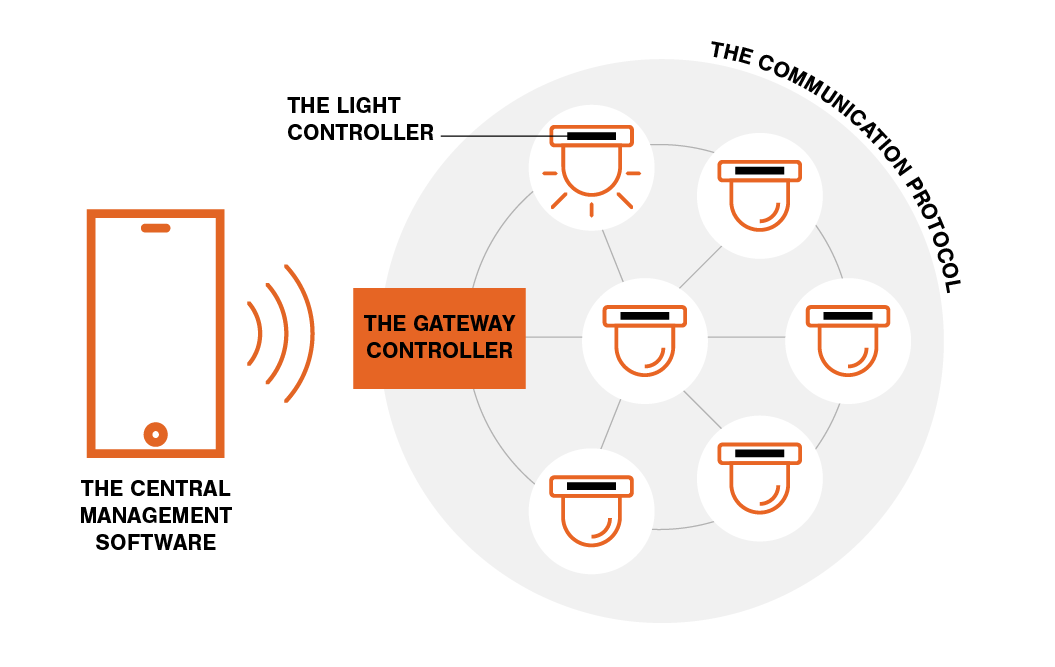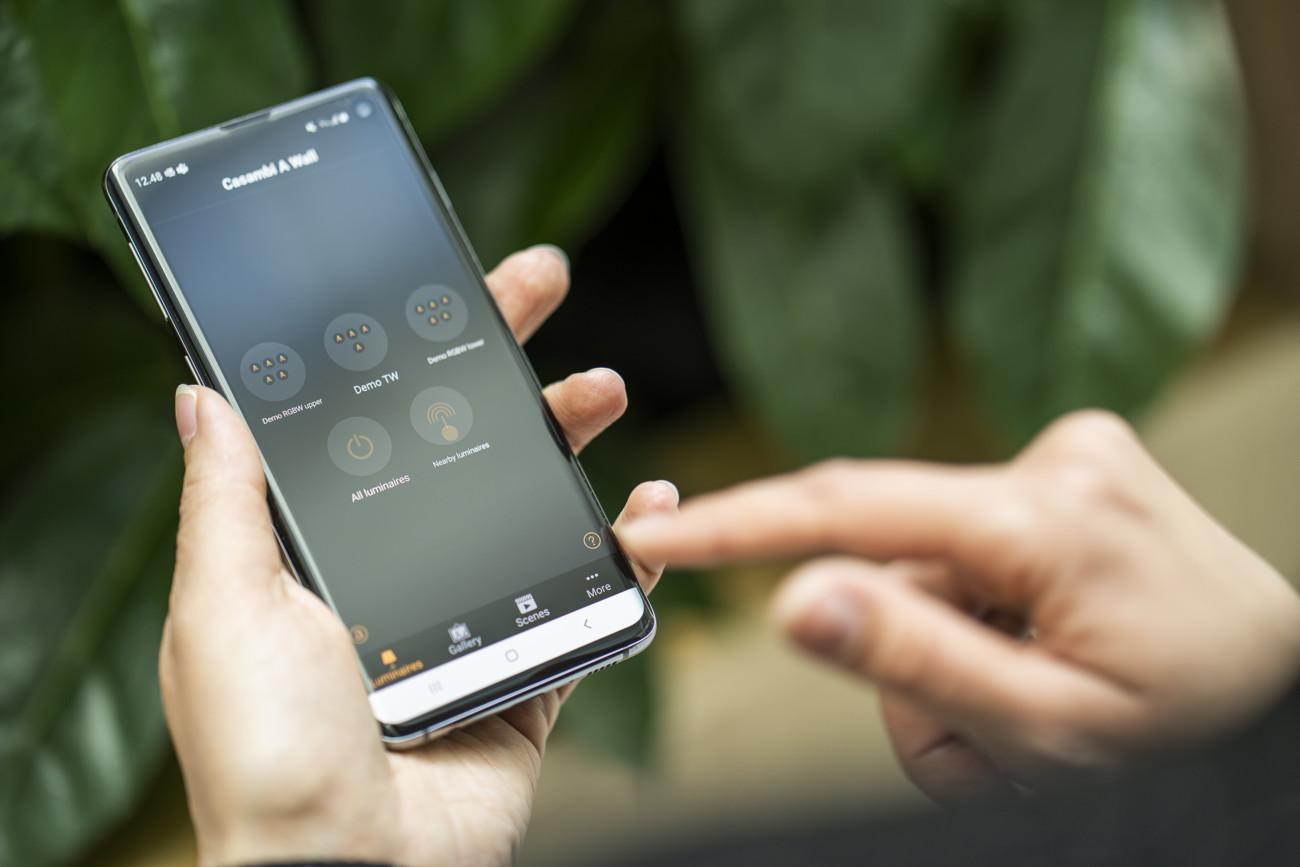
Introduction
High-quality lighting in schools is known to significantly improve the wellbeing and performance of students and staff. Research has shown that school facility design affects student learning, attendance, and teacher turnover rates*. In addition, students consider lighting an important design factor in classroom environments**. A year-long study conducted by Dr. Michael Schulte-Markwort, Director of the Clinic for Psychosomatics in Children and Juveniles at the University Medical Centre Hamburg-Eppendorf, found that correct lighting in the classroom, in terms of intensity, color temperature, and dynamism, helps to increase reading speed by 35%, and reduces comprehension errors by 45%. It was also shown that warm lighting can reduce hyperactivity in the classroom by up to 76%.
The methodology for education has also changed. The 21st Century education model is predicated on project-based learning and encourages more dialogue, collaboration and exploration. To facilitate this new approach to learning, education spaces need to be flexible, multifunctional and easily modifiable. Open plan configuration should simultaneously allow for multiple uses; for public presentations, quiet reading, teamwork, privacy and creativity. The well-being of students and school staff is also a priority, maintained by the use of more natural light and improved environmental conditions such as good lighting, air quality and acoustic comfort.
*D.J. O’Neill, A.D. Oates, The impact of school facilities on student achievement, behavior, attendance, and teacher turnover rate in central Texas middle schools, Educ. Facil. Plan, 36 (2001), pp. 14-22
** N. Castilla, C. Llinares, J.M. Bravo, V. Blanca, Subjective assessment of university classroom environment, Build. Environ., 122 (2017), pp. 72-81
How wireless smart lighting control can help solve today’s challenges
Wireless smart lighting control caters well to today’s education facilities by directly answering the need for powerful, highly customizable lighting control while tapping into further energy savings with sensors, switches, and other smart devices.
Application highlights:
The building blocks of smart lighting control
Wireless smart lighting systems principally comprise four elements:
- The light controller This is the communication transceiver that controls the driver or the light-sensitive module within a luminaire itself.
- The central management software This gathers data and controls all the luminaires in the lighting network. Isolated lights can be remotely controlled or can be grouped together and controlled synchronously.
- The communication protocol This is the system of rules that allows lights within a network to exchange messages without the need for wired communications.
- The gateway controller This aggregates communication from the light controllers and backhauls data to a central management platform. Building management personnel can remotely monitor their lighting networks and analyze performance dashboards in real-time.

How Casambi can help
Casambi offers the perfect solution to meet the modern schools’ stringent lighting control demands. Casambi wireless lighting controls are based on BLE (Bluetooth Low Energy), which is the only low-power wireless technology found in all modern smartphones, tablets, and even smartwatches.
The same technology is embedded into hundreds of luminaires and devices from all the major lighting manufacturers. This enables you to enjoy the benefits of smart lighting in your facility without the need for special wiring, or complex hardware requirements.
Casambi’s open ecosystem architecture is a generation ahead of the proprietary legacy systems currently on the market. All of the company’s native products and all of its partners’ Casambi Ready products are 100% compatible with each other. The technology is also integrated into fixtures, drivers, switches, sensors, and a diverse collection of modules.
Casambi collaborates with a vast number of leading luminaire, driver, LED board, LED lamp, and lighting control module manufacturers. Currently, there are 1000+ (and counting!) Casambi-enabled products available – all utilizing the simplicity of safe and reliable wireless communication. Thanks to its simplified system architecture and user interfaces, Casambi is easy and fast to specify, install, commission, and use.
Application highlights:
- Occupancy detection.
- Scheduling and timers – You can create bespoke time-based scenes that switch or dim luminaires to preset levels.
- Daylight harvesting and daylight responsive blind controls.
- Circadian lighting profile / human-centric-lighting.
- Simple end-user interface on mobile devices for individual lighting control.
- Non-disruptive installation and easy commissioning.
- Changes in control groups or light scenes can be applied anytime by facility staff.
- Reduced operational costs.
- Wireless emergency lighting with automated testing and reporting.
- Open platform to monitor energy savings and control assets.
How It Works
- No special wiring for lighting controls is needed. Decisions on lighting control groups can be made or updated at any stage, without any interruption to installations.
- The typical range for wireless connectivity is 30 meters for indoors, and 50 meters for outdoors. Bluetooth 5, compared to its predecessor Bluetooth 4, quadruples the wireless range from 50 up to 200 meters in free air.
- All devices (nodes) within a Casambi mesh network carry the complete system intelligence, and all nodes speak to each other. Unlike other wireless communication technologies, there are no central communication units that could become a weak link for uninterrupted communication. If one node fails, the communication continues via other nodes.
- All system configurations and end-user controls are handled via the Casambi App on mobile devices, available for free on iOS and Android.
- A Casambi network can contain up to 250 devices and an unlimited number of networks can be created in a single site, giving endless possibilities to scale up in the future.
- Each Casambi network can be connected to existing DALI networks, via the Casambi DALI gateway

Sample application
Advanced:
- Groups of luminaires are automatically dimmed or switched according to daylight levels, occupancy status, and scheduling.
- Occupancy detection with control zoning, allows for dimming of luminaires within specified zones where no motion is detected.
| Control type | Functionality |
|---|---|
| Daylight harvesting | Light outputs of luminaires are adjusted based on the available natural light measured by an open loop daylight sensor |
| Circadian scene | The color temperature (K) of luminaires is adjusted based on the time of day |
| Motion detection (Presence) | Occupied: Run Circadian scene Unoccupied for 20 minutes: Turn off lights |
| Manual control | Lighting is controlled by the class instructor, who uses the Casambi App for scene selection spanning class/projection/club hours/ and other programmed scenes |
Basic:
- Manual control and occupancy detection with 2 control zones
| Control type | Functionality |
|---|---|
| Manual control | Manual switching from wall mounted Casambi Ready wireless switch |
| Motion detection (Presence) | Unoccupied for20 minutes: Turn off lights |
Casambi benefits for schools
Full functionality for dynamic light settings
- Circadian rhythm / human-centric lighting.
- Daylight responsive lighting and blind controls.
- Occupancy detection.
- Scheduling and timers (i.e. lights are on only during weekdays 08:00-18:00).
- Multiple light scenes,which the instructor can select from the app/switch.
100% interoperability in the Casambi Ecosystem
- The Casambi Ecosystem consists of 1000+ interoperable lighting products, including luminaires, drivers, sensors, switches, dimmers and other control gear from all major lighting manufacturers.
- All ecosystem products share the same core, meaning 100% interoperability and full performance, for today and the future.
Maximum flexibility and scalability
- Casambi offers unlimited scalability – a single network consists of 250 units and an endless number of networks can be created and used in a single site, giving the end user endless possibilities to scale up in the future. You can implement smart controls in one single room and later extend it to a campus-wide installation, including both indoor and outdoor spaces. As the hardware complexity is reduced to a minimum, all that you need is Casambi-enabled luminaires, switches or sensors.
- No additional tools or software are needed to configure and use a Casambi network – just a smartphone or tablet and the Casambi App, free to download for iOS and Android.
- Space layouts, room partitions or preferences may change – with the easy-to-use Casambi app, you can change control groups, light scenes and create new ones at any time. In wired systems, changes in control groups can be difficult as the flexibility is limited with the communication cables being installed at the time of construction.
- With Casambi, such changes can be performed remotely and at any time without the need to visit the site for simple scene updates.
Secure and robust
- Full encryption of communication between mobile devices and end nodes and security measuresfor authorization means all data that is transmitted in a Casambi network is 100% protected and safe.
- Fail-safe & self-healing network: All nodes in a Casambi mesh network carry a backup of the entire system, which speeds up the communication and makes the communication more robust.
- All Casambi Ready products are built in a standardized hardware and software environment, and allCasambi components receive over-the-air updates. New functions are also made available to the user regularly and free of charge.
Easy to install, commission and use
- Install:
- No wiring for lighting control means fast and non-disruptive installation for buildings in use.
- Simple network – BLE is the only low power wireless technology found in all modern smartphones, tablets and even smart watches. No additional IT equipment, software or licenses are required to commission and operate the lighting control network. Additionally, no data communication cables, dongles, or gateways are needed.
- Commission:
- No additional tools or software are needed to configure and commission a Casambi network – just a smart phone or tablet and the Casambi App, free to download for iOS and Android.
- With the intuitive Casambi App, commissioning is simple and quick.
- For buildings in use, the end users can change control groups, light scenes and create new ones at any time. Changes can also be performed remotely, without the need to visit the site, for simple scene updates.
- Use:
- All products in a Casambi network can be controlled via a mobile device with the Casambi App, as well as any wall-mounted or wireless switches from the Casambi ecosystem.
- Casambi CBU units can be placed as external devices to the luminaires, making them a building asset, which can then be reconfigured and used with changes in functions, tenants, etc. This makes Casambi a completely future-proof lighting control solution.
Cost savings at every step of your project:
- Up to 40% energy savings can be achieved by using a multiple control strategy combining occupancy detection and daylight harvesting. With Casambi, any existing light installation can be upgraded to include occupancy and daylight sensors.
- Easy and fast installation due to no special wiring needed for data communications, and rapid commissioning via the Casambi App helps save you time and money.
- Automatic testing and reporting of the Casambi wireless emergency lighting system provides savings on operational costs thanks to eliminated periodic on-site manual testing.
- Simple commissioning tasks can be handled by facility managers, or our commissioning partners can provide quick and reliable recommissioning services. The simplicity of Casambi networks saves time and costs on the recommissioning of networks in operating buildings.
DALI Interface
- With the Casambi Wireless DALI Gateway, wired installations can be expanded wirelessly, making Casambi the ideal solution for renovations or extensions.
Wireless emergency lighting
- The wireless emergency lighting system, developed by Casambi and Tridonic, offers a simple yet failsafe solution whereby the mains and emergency lighting fittings can be part of the same mesh network. Additionally, automatic system monitoring and reporting can be run centrally and over the cloud. All test data can then be later accessed locally and via a web browser.
- The Casambi wireless emergency solution, unlike other wireless emergency lighting systems, brings additional strength to the wireless mesh and overall system, as well as supporting DALI DT1 standard devices – meaning reliable interoperability with DALI local battery emergency control gear. DT1 interoperability provides advanced data extraction capabilities from devices for any other analytics that may be required.
- With Casambi, your emergency lighting control system can be future-proofed for any data extraction and processing requirements that may arise in the future; all thanks to the possibility of receiving automatic firmware upgrades and new features over the air.
Tap into the IoT world
- Through its Cloud API, Casambi networks can be integrated into IoT tools that enable network monitoring and the usage of collected data from the network – your lighting network then becomes part of the smart building infrastructure.
- You can monitor and visualize all data from the Casambi network, such as energy consumption, occupancy patterns or air quality.
Case study
Oxford University Bodleian Library

The Bodleian Library at Oxford University is one of the oldest libraries in Europe and has parts that date back to 1487. It is the main research library of the University of Oxford and holds over 12 million items, occupying five buildings.
The library has been updated with state of the art lighting and lighting controls with the latest technology from Casambi. The task at hand was to enhance the lighting functionality of the space without disturbing the original architecture. Casambi’s CBU-ASD (a wireless control unit for LED drivers with 0-10V, 1-10V, or DALI dimming interface) was small enough to fit into the refurbishment design, so no customization had to be done. The library’s 170 luminaires are separated to two different networks and the staff of the library controls the lighting via Casambi Xpress switches. Xpress is used to recall scenes and to turn off the lighting when the library is closed. A “fade to zero” functionality has been implemented for the staff of the library to exit before the lights are completely turned off. Existing occupancy sensors were equipped with Casambi CBU-ASD modules to gain wireless connectivity and to enable presence/absence detection and daylight dimming, ensuring lights are only on when they are needed.
Being completely wireless, Casambi was the ideal solution for quick and non-disruptive installation, where the library remained in use during the refurbishment.
Customer benefits:
- A wireless control system that enables the user to personalize their lighting via the intuitive Casambi App.
- A 1:1 replacement of the luminaires without changing the existing electrical installation
- Energy savings using Casambi-enabled presence/absence detection and daylight harvesting.
- Quick and non-disruptive installation.
- Casambi Xpress wireless switches, which provide another easy way for staff to control the lights.
Meet the Team
Casambi announced this year the formation of a Specification Success Team. Their mission is to see that all specification customers have a great experience using Casambi. Presently, the team comprises four lighting control design specialists, spanning four countries and with a deep collective knowledge of the smart lighting movement.
Duygu Cakir – based in Istanbul, Turkey

Duygu is the team lead. She joined the company in 2021 from SLD Studios, where her experience as partner and principal consultant in the EMEA region is key as Casambi fortifies its support strategy. Duygu has overseen many projects of scale from airport terminals, multi-use complexes, offices, commercial centers and much more. Listed in ‘40 Under 40’ by Lighting Magazine UK, Duygu is a highly knowledgeable and formidable industry force. She holds a BSc in Electronics and Communications Engineering, an MSc in Lighting Design and Technology, and an MSc in Energy Technologies and Management.
‘Casambi’s platform can help achieve complex functionality with ease. As a team, we are on a drive to raise awareness amongst specifiers of the simplicity of planning a project with Casambi controls. It’s something they can do without relying on a specialist. We can attest to this because we, too, were once specifiers and therefore have a deep understanding of the daily challenges faced by our clients’
Leticia Mori – based in Madrid, Spain

Leticia is a civil/structural engineer with a master’s degree in Energy Efficiency. Over the years, Leticia has worked on many kinds of lighting projects spanning the industrial, hospitality, office, residential, and retail segments. She has participated in every phase of these projects from understanding clients’ needs to delivering fixtures on-site, and everything inbetween including lighting calculations, plans, technical documentation, and purchasing.
‘The world is constantly changing and nowadays we look for simpler and faster solutions. This is exactly what Casambi offers in the lighting field: a wireless lighting control solution that is quick and easy to install, and a powerful user interface – the Casambi app – that anyone can use. In addition, Casambi’s solution is proven to reduce energy consumption and promote well-being as it offers many control possibilities such as dimming, daylight control, circadian rhythm, timer, and so on. This speaks to my heart as someone who has conducted energy efficiency studies.’
Selen Celik-Gungor – based in Espoo, Finland

Selen holds a bachelor’s degree in architecture and has completed two master’s degrees in lighting design. She has worked as both an architect and a lighting designer. Her main responsibilities have spanned concept development, lighting planning, and calculations. On each of her projects, Selen focused on the relationship between light & human, light & science, and light & space.
‘We as designers are always talking about energy-saving and LED technology. I believe Casambi is one of few companies that truly enables energy-smart functionality and easy/flexible control of lighting designs. Controlling is not a new topic for us within the lighting industry, but Casambi has brought a new freshness with its features. I believe, nowadays, lighting design should be less about the final design and more about selecting the right product and technology depending on the project.’
Karla Martin – based in Milan, Italy

Karla obtained a bachelor’s degree in Industrial Design before going on to complete a master’s in Virtual Architecture and Interior. She has been working in architecture studios ever since.
‘I’ve worked as a lighting designer for many years – initially working with DALI. When I first discovered Casambi, I was bowled over by its simplicity, scalability, problem-solving capabilities, and the endless list of options it offers. Oftentimes, the first reaction to wireless tech is pretty negative or cautionary. There is this assumption that it will be overly complicated and expensive. I want to change this incorrect perception and open my industry peers’ eyes to the possibilities with Casambi.’








